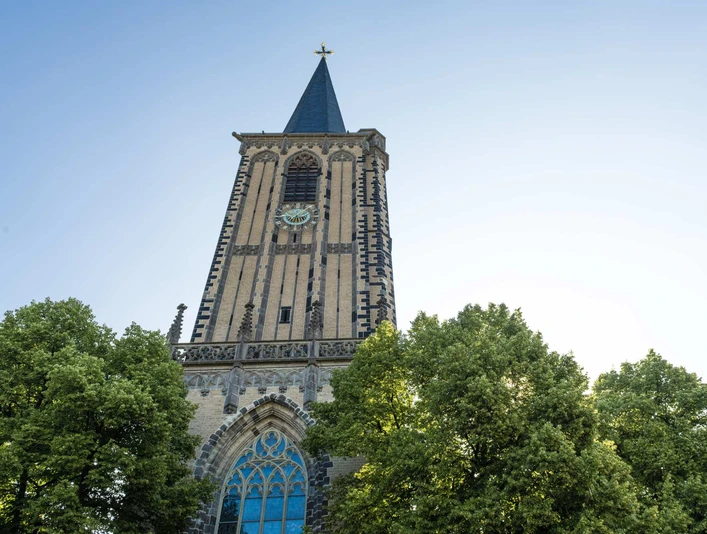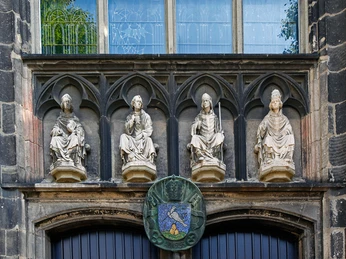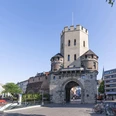- Photos & Map
How would you like to arrive?
- Call
- Details
- Useful Information
- Nearby
In Cologne, there are saints believed to be responsible for the city's weather. Saint Severin is the patron of rain, protecting against misfortune and drought. It is said that when Severin's relics arrived in Cologne, heavy rains ended a prolonged drought. Such a patronage draws from tradition, legends, and, as in this case, sometimes manifests even in the present.
A second occurrence happened in 1999: During a relic procession, rain penetrated the shrine. When it was opened for restoration purposes, alongside valuable insights and remains, ancient silk fabrics dating back to as early as the 4th century were discovered. Thus, rain is uniquely connected to St. Severin, granting Cologne a blessed time. Is that really a coincidence?
Standing 79 meters tall, St. Severin is considered the second tallest among the 12 Romanesque churches in Cologne, offering a wealth of architectural history, valuable furnishings, and intriguing stories, legends, and events.
Recent intriguing events took place around 1999: The relic shrine had to be opened due to possible damage, revealing an 11th-century wooden casket containing not only bones, grape seeds, leather, and mouse bones but also eight silk and linen cloths and fragments, some still colored, dating to the 4th–5th and 7th–10th centuries. One of these fabrics, at the time as precious as gold, measures 274 x 134 cm, making it the largest preserved medieval silk fabric. Since the casket may have been opened only five times, as testified by the seal residues on the outside, the fabrics were protected from light, retaining their structure and color.
A second occurrence happened in 1999: During a relic procession, rain penetrated the shrine. When it was opened for restoration purposes, alongside valuable insights and remains, ancient silk fabrics dating back to as early as the 4th century were discovered. Thus, rain is uniquely connected to St. Severin, granting Cologne a blessed time. Is that really a coincidence?
Standing 79 meters tall, St. Severin is considered the second tallest among the 12 Romanesque churches in Cologne, offering a wealth of architectural history, valuable furnishings, and intriguing stories, legends, and events.
Who was St. Severin?
Severin likely hailed from Bordeaux, became the third bishop of Cologne in the 4th century, and was swiftly canonized after his death. Each year, on the Sunday following his feast day on October 23, the Severin Festival is held, where the community carries the Severin shrine in a procession with song, prayer, and candles through the evening-dark streets of the Severin district.Opening of the Relic Shrine in 1999
Of the original 11th-century shrine of Saint Severin, probably only a small piece remains today: an enamel medallion with the image of St. Severin. Experts cannot confirm this thesis precisely, as the original relic shrine was melted down around 1795, and replicas and drawings present an ambiguous picture. Today, the saint's remains rest in an shrine on stilts from 1819, allowing believers to receive blessings from above in humility as they pass beneath.Recent intriguing events took place around 1999: The relic shrine had to be opened due to possible damage, revealing an 11th-century wooden casket containing not only bones, grape seeds, leather, and mouse bones but also eight silk and linen cloths and fragments, some still colored, dating to the 4th–5th and 7th–10th centuries. One of these fabrics, at the time as precious as gold, measures 274 x 134 cm, making it the largest preserved medieval silk fabric. Since the casket may have been opened only five times, as testified by the seal residues on the outside, the fabrics were protected from light, retaining their structure and color.
Church Furnishings: Objects and Mosaics
Besides exhibits from St. Severin's eventful history, you can view several valuable objects and furnishings in the church: a 12th-century mosaic slab, a Romanesque stained glass window in the southern aisle, a late 13th-century choir stall, a 14th-century plague cross, vaulted paintings, wall paintings, numerous epitaphs, and a depiction of the Last Supper around 1550–55 by Barthel Bruyn the Elder. "The Cornelius Horn," prepared as a reliquary around 1500, also belongs to the church treasure. Once a week, the congregation passes under the shrine and past the horn during the "Hörnchenmesse," a tradition dating back to the Middle Ages.Overview of St. Severin's Architectural History
Where St. Severin now stands were once Roman burial sites, as with St. Ursula and St. Gereon, and a road leading towards Bonn, today's Severinstrasse. Since the 4th century, a small chapel can be traced at the site, which was enlarged and altered over the centuries until the 11th century, when the construction of a Romanesque basilica with a crypt began. Between the 14th and 16th centuries, the nave was renewed in late Gothic style, among other renovations. Nevertheless, the foundations and walls of St. Severin and some of its furnishings remain originally Romanesque; there is even a Romanesque altar you can view in the rear of the choir.Artistic Tower Cross
Before you enter or leave St. Severin, look up at the tower and the tower cross, designed by the Cologne artist Heinz Gernot in 1961. You will see a cross-flower-like structure made of intersecting shapes, golden spheres, and circular wrappings associating planetary orbits or life paths with the cross, with faith at the center. Here, too, the blessing seems to come from above, spanning the Severin district.Useful Information
Eligibility
Bad Weather Offer
Suitable for any weather
for Groups
for Class
for families
for individual guests
Suitable for the Elderly
Openings
Payment methods
Entrance Free
Parking facilities
The walk from the stop "Chlodwigplatz" ( Tram: 15, 16, 17) to the church St. Severin takes about 4 minutes.
General information
Bus stop available
Our recommendations
Nearby



